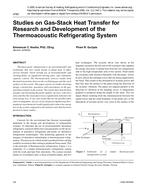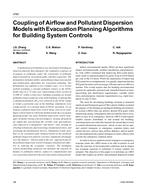-
-
Available Formats
- Options
- Availability
- Priced From ( in USD )
-
Available Formats
-
- Immediate download
- $16.00
- Add to Cart
Customers Who Bought This Also Bought
-

4780 - Studies on Gas-Stack Heat Transfer for Research an...
Priced From $16.00 -

4749 - A Survey Technique for Evaluating Heating, Ventila...
Priced From $16.00 -

4746 (RP-1253) - Measurement of Solubility, Viscosity, an...
Priced From $16.00 -

4760 - Coupling of Airflow and Pollutant Dispersion Model...
Priced From $16.00
About This Item
Full Description
An experimental and numerical study of fluid flow and heat transfer in residential electric hot water tanks with sidewall inlets is presented in this paper. The semi-empirical model proposed here divides the tank into two distinct regions: a piston-type flow region, where the axial flow velocity is uniform, and a fully mixed uniform temperature region at the bottom of the tank near the cold water inlet. The piston-type region is treated numerically using a quasi-one-dimensional model, while the height of the fully mixed region is based on an experimentally derived correlation.
A full-size transparent tank is used to visualize fluid motion in the fully mixed region. Results of these flow visualization studies, combined with temperature measurements, have led to the development of an empirical correlation relating the rate of growth of the height of the mixed region to the entrance Richardson (Ri) number and a dimensionless time parameter representing the percentage of tank discharge. The results obtained in this study confirm that the effects of mixing cannot be neglected. The semi-empirical model is validated against experimental data for constant and varying inlet Ri
The results for constant Ri agree favorably with the experimental data except at the beginning of the discharge process, where the presence of a small stratification zone cannot be predicted by the model. The results also show that the thermocline and the outlet temperature predictions have a high level of agreement with experimental results. The proposed model is also checked for varying Ri conditions. In this case, the proposed model was able to capture accurately the successive formation of two different fully mixed regions separated by an intermediate thermocline.
Units: SI





